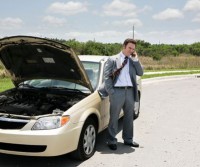
 Summer’s heat, dust, and stop-and-go traffic, will take their toll on your vehicle. Add the effects of last winter, and you could be poised for a breakdown. You can lessen the odds of mechanical failure through periodic maintenance…Your vehicle should last longer and command a higher resale price, too!
Summer’s heat, dust, and stop-and-go traffic, will take their toll on your vehicle. Add the effects of last winter, and you could be poised for a breakdown. You can lessen the odds of mechanical failure through periodic maintenance…Your vehicle should last longer and command a higher resale price, too!
Some of the following tips are easy to do; others require a skilled auto technician.
-
Air Conditioning
A marginally operating system will fail in hot weather. Have the system examined by a qualified technician. Newer models have cabin air filters that clean the air entering the heating and air conditioning system. Check your owner’s manual for location and replacement interval
-
Cooling System
The greatest cause of summer breakdowns is overheating. The cooling system should be completely flushed and refilled about every 24 months. The level, condition, and concentration of the coolant should be checked periodically. (A 50/50 mix of antifreeze and water is usually recommended.) DIYers, never remove the radiator cap until the engine has thoroughly cooled! The tightness and condition of drive belts, clamps, and hoses should be checked by a pro.
-
Oil
Change your oil and oil filter as specified in your manual more often (every 3,000 miles) if you make frequent short jaunts, extended trips with lots of luggage, or tow a trailer.
-
Engine Performance
Replace other filters (air, fuel, PCV, etc.) as recommended more often in dusty conditions. Get engine drive-ability problems (hard starts, rough idling, stalling, diminished power, etc.) corrected at a good shop.
-
Windshield Wipers
A dirty windshield causes eye fatigue and can pose a safety hazard. Replace worn blades and get plenty of windshield washer solvent.
-
Lights
Inspect all lights and bulbs; replace burned out bulbs; periodically clean dirt and insects from all lenses. To prevent scratching, never use a dry rag.
-
Tires
Have your tires rotated about every 5,000 miles. Check tire pressures once a month; check them while they’re cold before driving for any distance. Don’t forget to check your spare as well and be sure the jack is in good condition. Examine tires for tread life, uneven wearing, and cupping; check the sidewalls for cuts and nicks. An alignment is warranted if there’s uneven tread wear or if your vehicle pulls to one side.
-
Brakes
Brakes should be inspected as recommended in your manual, or sooner if you notice pulsations, grabbing, noises, or longer stopping distance. Minor brake problems should be corrected promptly.
-
Battery
Batteries can fail any time of year. The only accurate way to detect a weak battery is with professional equipment. Routine care: Scrape away corrosion from posts and cable connections; clean all surfaces; re-tighten all connections. If battery caps are removable, check the fluid level monthly.Avoid contact with corrosive deposits and battery acid. Wear eye protection and rubber gloves.
-
Emergencies
Carry some basic tools — ask a technician for suggestions. Also include a first aid kit, flares, and a flashlight.
Source: National Institute for Automotive Service Excellence (ASE).

Every day, people from one side of the country to the next take to the roadways. Some do so for work and others for pleasure. Regardless of why you are hitting the road, there is always the chance that your car will breakdown.
While you can protect against this with the proper maintenance schedule, even then there is no way of guaranteeing that a breakdown will never occur.
Here are five things to do if you find yourself in this position:
1. Remove your car from traffic, if at all possible. Even if something goes terribly wrong with your vehicle, you should still be able to drive it to the shoulder of the road.
Note: If this is not possible, do not get out of your vehicle until you are 100 percent sure you can do so in a safe manner.
2. Call for help. Regardless of your situation, it is best to call for help as soon as it is safe to do so. From the police to a tow truck driver, decide who to call and then start dialing.
3. Alert others that you are in trouble. The use of hazard lights is a good start, but you may want to take things one step further by placing road flares 25 to 50 feet behind your vehicle (only if it is safe to do so).
4. Opt against a do-it-yourself repair. As tempting as it may be to pop the hood and take a closer look, this is not always the ideal time to do so. Your safety comes first, and attempting to make a repair on a crowded road is anything but safe.
5. Be patient. As frustrated as you may be, you need to exercise patience if your car breaks down. This will ensure your safety, while also giving you time to think through your situation.
Nobody wants to be in this situation, but if you find your car broken down the five tips above can be of great assistance.


